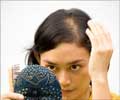People with curly hair have to deal with the problem of knotting out countless tangles. But a new study has quashed this knotty notion associated with curly hair by revealing that it is the straight hairs that have more tangles.
An alliance between hairdressers and physicists has tried to find out the answer to this tricky question through a real-life experiment.According to French researcher Jean-Baptiste Masson from the Ecole Polytechnique, in Palaiseau, the approximately 150,000 hairs on our heads are an enthralling but poorly understood phenomenon in the world of physics.
In his first real-life experiment, Masson asked a few hairdressers to count the tangles in people's hair late in the afternoon, a time when tangles have had a chance to develop.
Over the period of three weeks, the hairdressers studied 123 people with straight hair and 89 with curly hair, reports Discovery News.
The results after examination of the tangles were "clear and somewhat surprising", the physicist said.
Straight hair had almost twice as many tangles, defined as groupings of hair that resist combing, than curly hair. The average number of tangles was 5.3 for straight hair and 2.9 for curly hair.
Advertisement
Although curly hairs are more likely to come into contact with other hairs, Masson says that straight hairs tend to have bigger angles between them when they connect.
Advertisement
The researcher says that his work could have implications beyond the end of the hairbrush, with one achievable application being designing Velcro-like products.
The findings of the study have been published in the American Journal of Physics.
Source-ANI
SRM /J











